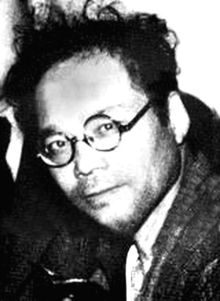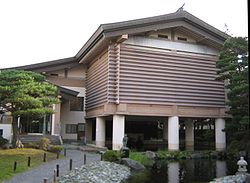- Shikō Munakata
-
Munakata Shikō 
Birth name Munakata Shikō Born September 5, 1903
Aomori, JapanDied 13 September 1975 (aged 72)
Tokyo, JapanNationality Japanese Field Painter, Printmaker Movement sosaku hanga, folk arts movement Awards Order of Culture, many others Shikō Munakata (棟方 志功 Munakata Shikō, September 5, 1903 – September 13, 1975), was a woodblock printmaker active in Shōwa period Japan. He is associated with the sosaku hanga movement and the mingei (folk art) movement. Munakata was awarded the "Prize of Excellence" at the Second International Print Exhibition in Lugano, Switzerland in 1952. He was awarded the Order of Culture, the highest honor in the arts by the Japanese government in 1970.
Contents
Early life
Munakata was born in Aomori city, Aomori prefecture in northern Honshū as the third of 15 children to a local blacksmith. Due to the impoverished circumstances of his family, he had only an elementary school education; however, he exhibited a passion for art from early childhood. In third grade, he began illustrating kites for his classmates.
Munakata later claimed that his artistic endeavors were sparked by Vincent van Gogh's (1853–1890) Still Life: Vase with Five Flowers, a reproduction of which was given to him by his teacher when he was 17. Upon viewing of van Gogh's artwork, young Munakata decided that he wanted to become the “van Gogh of Aomori”. In 1924, Munakata moved to Tokyo in order to fulfill his decision to become a professional painter in oils.
Munakata's early career was not without obstacles. Unable to sell his paintings, he was forced to repair shoes and sell natto part time to survive. He was rejected by the Bunten (The Japan Art Academy Exhibition) four times, until one of his paintings was finally accepted in 1928. However, by this date, his attention had shifted away from oil painting to the traditional Japanese art of woodblock printing.
The Path towards Woodblock Prints
In 1926, Munakata saw Kawakami Sumio's black-and-white woodcut Early Summer Breeze, and decided to work on black-and-white prints. From 1928 onwards, Hiratsuka Unichi (1895–1997), another renowned sosaku hanga printmaker, taught Munakata wood carving. In 1929, four of his prints were accepted by the Shunyokai Exhibition, which bolstered his confidence in the new medium. In the following year, four more of his works were accepted for the Kokugakai national exhibition, thus establishing him in his career.
In 1935, Yanagi Soetsu (1889–1961), father of the mingei (folk art) movement, saw Munakata's prints at the Kokugakai's annual spring exhibition, and bought twenty-five prints of Yamato shi Uruwashi by Munakata. This event changed Munakata's life. From then on Munakata was closely associated with the Japanese folk art movement. In 1936, Munakata went to Kyoto and visited many Buddhist temples and saw many sculptures. Munakata's exposure to Buddhist religious imagery influenced his artistic style significantly. Ten Great Disciples of the Buddha (1939) is considered to be his greatest masterpiece.
Munakata's house and most of his woodblocks were destroyed in the American firebombing of Tokyo in May 1945 his pet was also killed. He relocated to Fukumitsu Town, Toyama Prefecture from 1945-1951.
Postwar period
After World War II, Munakata produced numerous woodblock prints, paintings in watercolor and oil, calligraphy, and illustrated books. He moved his studio to Kamakura, Kanagawa to be closer to Tokyo. He traveled overseas to the United States and Europe in 1959, giving lectures at a number of overseas universities. His works received critical acclaim both in Japan and overseas, and he received many prizes.
Munakata was awarded the "Prize of Excellence" at the Second International Print Exhibition in Lugano, Switzerland in 1952, and first prize at the Sao Paulo Bienal Exhibition in Brazil in 1955, followed by Grand Prix at the Venice Biennale in 1956. He was awarded the Order of Culture, the highest honor in the arts, by the Japanese government in 1970.
Munakata died at his home in Tokyo. His grave is in Aomori, and his gravestone is patterned after that of Vincent van Gogh.
Subject Matter and Technique
Munakata took many of his themes from the traditions of his native Aomori in northern Japan, including the local people's love of nature and folk festivals such as the Nebuta festival. Munakata's belief and philosophy were engrained in Zen Buddhism. His prints feature images of floating nude females representing Shinto kami that inhabit trees and plants. Inspired by poetry of the Heian period, Munakata also incorporated poetry and calligraphy into his prints.
This extremely shortsighted artist brought his face almost into contact with the wood when he carved. In his words, “the mind goes and the tool walks alone”. Munakata carved with amazing speed and scarcely used any preparatory sketches, producing spontaneous vitality that is unique to his prints. During the early stage of his career, Munakata worked exclusively on black-and-white prints. Later on, upon the advice of Yanagi Soetsu (1889–1961), Munakata colored his prints from the back, a technique called urazaishiki.
Munakata's Philosophy on Woodblock Prints
Unlike Kōshirō Onchi (1891–1955), father of the sosaku hanga movement, who advocated artists’ expression of the “self” in creating prints, Munakata disclaimed all responsibilities as creator of art. For Munakata, artistic creation is one but many of the manifestations of nature's force and beauty, which is inherent in the woodblock itself. Munakata called prints “itaga” instead of “hanga”[citation needed], emphasizing the material instead of the process of printing. (written in the same kanji, “han” refers to the process of printing, whereas “ita” refers to the woodblock itself). In Munakata words, “the essence of hanga lies in the fact that one must give in to the ways of the board…there is a power in the board, and one cannot force the tool against that power.” Munakata’s subject matter and artistic style are very much characterized by his philosophy on the supremacy of the woodblock material and nature’s inherent force and beauty.
Quotations of Shiko Munakata
"Like the vastness of space, like a universe unlimited, untold, unattainable, and inscrutable- that is the woodcut."
"The nature of the woodcut is such, that even a mistake in its carving will not prevent it from its true materialization."
"The concern that it be ugly is characteristic of human thoughts and not of the woodcut itself."
"It is inherent in the woodcut that it can never be ugly"
"The woodcut, unconcerned with good and evil, with ideas, with differences, tells us that it consists of truth alone,"
"It is precisely the beauty of this <way> which will further enlarge the limitlessness of the world of beauty."
(from Shiko Munakata, Munakata: the “Way” of the Woodcut, Brooklyn, Pratt Adlib Press, 1961).
Philately
One of Munakata’s works, “Benzaiten”, appeared on a 1982 commemorative postage stamp issued by the Japanese government as part of a series on modern Japanese art.
References and further reading
- Castile, Rand. Shiko Munakata (1903–1973): Works on Paper. New York: Japan Society, 1982. ISBN 091330414X
- Kawai, Masatomo. Munakata Shiko: Japanese Master of the Modern Print. Art Media Resources (2002). ISBN 1588860213
- Munakata, Shiko. Munakata: the “Way” of the Woodcut. Brooklyn, Pratt Adlib Press, 1961. ASIN: B0006AY8HK
- Singer, Robert T. and Nobuho, Kakeya. Munakata Shiko: Japanese Master of the Modern Print. Philadelphia and Los Angeles: Philadelphia Museum of Art and Los Angeles County Museum of Art, 2002. ISBN 1-58886-021-3
- Yanagi, Sori. The Woodblock and the Artist: the Life and Work of Shiko Munakata. Tokyo, New York: Kodansha International, 1991. ISBN 4-7700-1612-3
External links
Categories:- 1903 births
- 1975 deaths
- Japanese printmakers
- Japanese painters
- People from Aomori (city)
- Sosaku hanga artists
Wikimedia Foundation. 2010.

